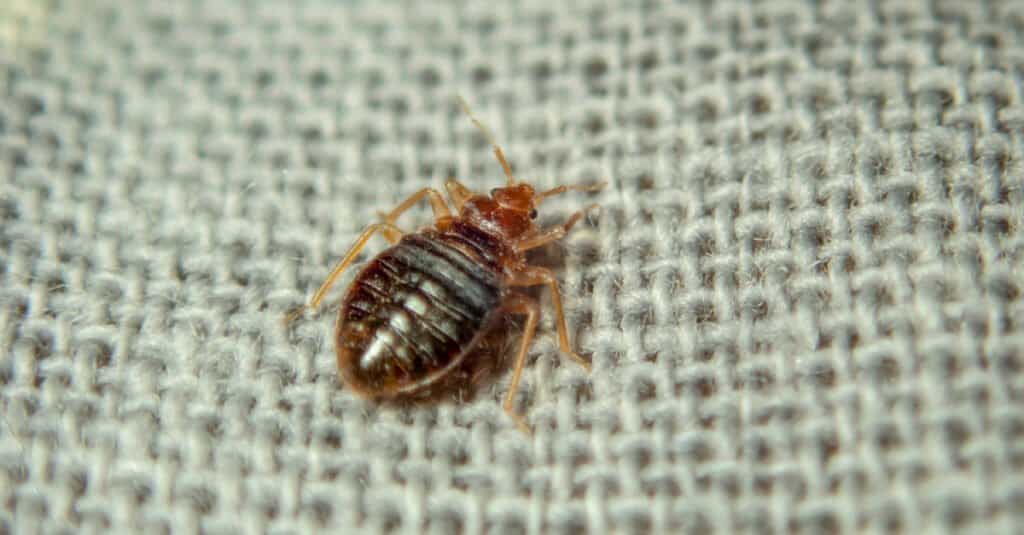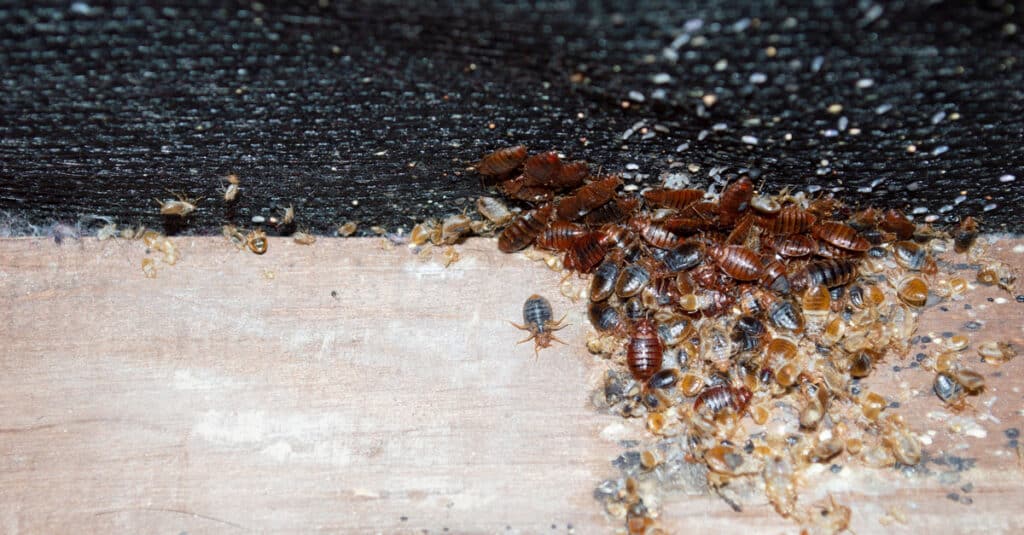While bed bugs aren’t directly associated with the spread of disease, they can be one of the most pervasive and persistent pests in your home. They can also be one of the most annoying. If you find yourself waking up every morning with red bites on your body, you could be dealing with an infestation of bed bugs. Understanding the appearance of bed bugs can help with identification and develop a treatment as soon as the early signs of an infestation appear. Here are the facts that you need to know if you’re worried about the appearance of bed bugs in your home.
What Bed Bugs Look Like
Identification of an adult bed bug is assisted by the fact that they can be seen by the naked eye — but that doesn’t mean that you’ll see them if you’re not actively looking. The average adult bed bug is roughly a quarter of an inch long in size and has a flat, ovular shape to its overall body. The most common point of reference for bedbug identification is that they’re the size of an apple seed. Adult bed bugs have no wings and appear as a dull brown color, but they become visibly redder right after they’ve fed on blood.
Identifying bed bug babies — which are also known as nymphs — can be significantly more difficult. Babies are only the size of a pin’s head, and they appear white or tan rather than the darker brown color of adults. Babies go through five growth phases where they shed their exoskeleton for a larger one and gorge on a hearty meal of blood to bulk up. While you might not be able to see these babies, their shed skins can be a sensible point of identification. Because the size, color, and shape of bed bugs are similar to other species — along with similar symptoms from being bitten — these insects are often misidentified. Ticks, fleas, mites, and lice all bear passing resemblances to one another but have their own unique treatment and prevention methods. These bugs can even be mistaken for baby cockroaches and spider beetles. If the facts aren’t 100% clear when trying to identify a bed bug infestation, the smart choice might be to bring in a professional.

©Dmitry Bezrukov/Shutterstock.com
Signs of a Bed Bug Infestation
You don’t need to see these bugs with your naked eye to be able to identify the early signs of an infestation. These early signs of infestation that can be identified by sight include bloodstains and excrement which will most commonly appear on a mattress or bedding. This smell is pungent but usually cloyingly sweet like certain types of berries. There’s also often a musty odor associated with bed bugs, but you’re likely only going to be able to use your sense of smell for identification until you’re well past the early signs of the bugs. If the infestation has reached a point where babies have begun growing into adults, you can also help spot an infestation by looking for shed skin and eggshells from babies that have already hatched.
Where to Look For Bed Bugs
These bugs strike mostly at night and only feed on humans for around 10 minutes at a time, so you may need to investigate where they live to get the real facts on your infestation. And while bed bugs earned their name because of their tendency to hide on a mattress, they’re known to hide in all manner of furniture. Everything from bare wood to upholstered leather to complex textiles can make a good home for a bed bug infestation just as long as there are wrinkles and crevices for them to hide in. These bugs are very good at hiding, but they prefer to stay near their hosts so that they can feed regularly. That means that surfaces closest to beds are the most likely hiding spots. Other pieces of furniture where members of the household like to nap — like couches and recliners — are also a likely source of homes for a community of bed bugs.
How to Identify Bed Bug Bites
If you wake up in the morning with bites, bed bugs might be to blame. And since they excrete a minor anesthetic when they first bite you, you might not even feel pain from the bite right away or even ever. These bugs don’t feed every day, so bites might not begin to display a noticeable pattern until the infestation is well along. These bug bites typically manifest in a straight line, but they may take on the appearance of a cluster of bites as well. Most bites will appear as small red bumps on the skin’s surface, and that means that bed bug bites are commonly mistaken for flea or mosquito bites. That means that evaluating the circumstances around the bite can be the most effective way to identify the source of the irritation.

©simon berenyi/Shutterstock.com
Why It’s Important to Stop an Infestation
These bugs aren’t known to be a vector in spreading disease, but the itching they cause can be highly irritating. In some rare instances, people can have a severe allergic reaction to bed bug bites that can be potentially life-threatening. They’re a relatively minor inconvenience, but bed bugs are notably hard to get rid of. Prevention requires more than just laying down some traps. As long as you aren’t suffering from an allergic reaction, you can treat a bed bug bite like you would treat most bug bites or similar sources of irritation. That includes antihistamines and over-the-counter antiseptic lotions or creams.
What to Do if You Find Bed Bugs
It’s important to recognize that having bed bugs in your home isn’t a reflection of your hygiene or that of your home. Since they feed exclusively on blood, bugs aren’t attracted to trash. Despite that, identifying that you’re actually dealing with a bed bug infestation and identifying the scale of that problem is critical to prevention. Thorough cleaning is the name of the game here. Since bedbugs will typically make their first home on a mattress and then expand outward, you should do the same in your search. Look at any seams, cracks, or spaces where they could fit.
Once you’ve identified where the bugs live, there are a few steps you can take to clear the population of adults out. That can include using a vacuum, a steam cleaner, or even freezing them out by dropping the temperature. All linens and clothing should be cleaned thoroughly, and be sure to look for any cracks in the molding or plaster to prevent them from finding new hiding spots. Traps can also be an effective choice, and that’s particularly true in smaller apartments with decently sized infestations.
Because these infestations are nothing to play with, you may want to turn to professionals in order to eradicate the pests. They will be able to use many different approaches to dealing with them. On top of that, you don’t want to halfway do the job and just continue their breeding and the infestation. Make sure to call pros with good references and years of experience. You want to be selective about who you let into your home!
Up Next:
Now that you know what they look like… let’s find out more!
- What Causes Bed Bugs? How a Bed Bug Infestation Starts Once upon a time… wait this is not a fairy tale beginning. It’s quite the opposite!
- Bed Bugs Exterminator: How to Pick the Right Company Is it time to take action? Make the call to the pros!
- Carpet Beetle vs Bed Bug: What are the Differences? Both are annoying and need to be dealt with, but you do need to know the difference before taking your next steps.
The photo featured at the top of this post is © iStock.com/smuay
FAQs (Frequently Asked Questions)
How can I tell if we have bed bugs?
Adult bed bugs are large enough to be seen by the naked eye, but you can also identify them by the presence of shedded skin, eggs, or fecal waste. If you can’t see them in the open, you can look in all the corners and crevices around or on a mattress in your house.
What can be mistaken for bed bugs?
Bed bugs are commonly mistaken for a wide variety of different bugs. People commonly mistake the bites of fleas, ticks, or even mosquitos for bed bugs. In terms of size and shape, they’re known to resemble both baby cockroaches and some beetle species.
Can you see bed bugs with the naked eye?
Adult bed bugs can be seen by the naked eye and are roughly the size of an apple seed. Baby bed bugs, also known as nymphs, are usually too small to see.
How do bed bugs start?
Most bed bug infestations start by hitching a ride on used furniture. But they can also carry a ride on clothing, purses, or bags. Bed bugs are relatively mobile pests as well and are capable of moving between units in hotels and apartment complexes.
What time of year are bed bugs most active?
Bed bugs are active all year long, but they’re at their most active during the warmer summer months. Just because you stop experiencing frequent symptoms or bites doesn’t mean that you don’t need to get rid of them with an active treatment method.
What instantly kills bed bugs?
While there are a number of different treatments and traps for bed bugs, the most effective way to kill them instantly is with the application of steam. The combination of heat and water is deadly.
Where do bed bugs like to hide?
Bed bugs like to hide near their main food sources — notably in small cracks and crevices near mattresses. Despite that, they can find their home in a wide variety of different surfaces. Thoroughly searching all-around furniture you use regularly is essential to get rid of bed bugs.
Thank you for reading! Have some feedback for us? Contact the AZ Animals editorial team.






